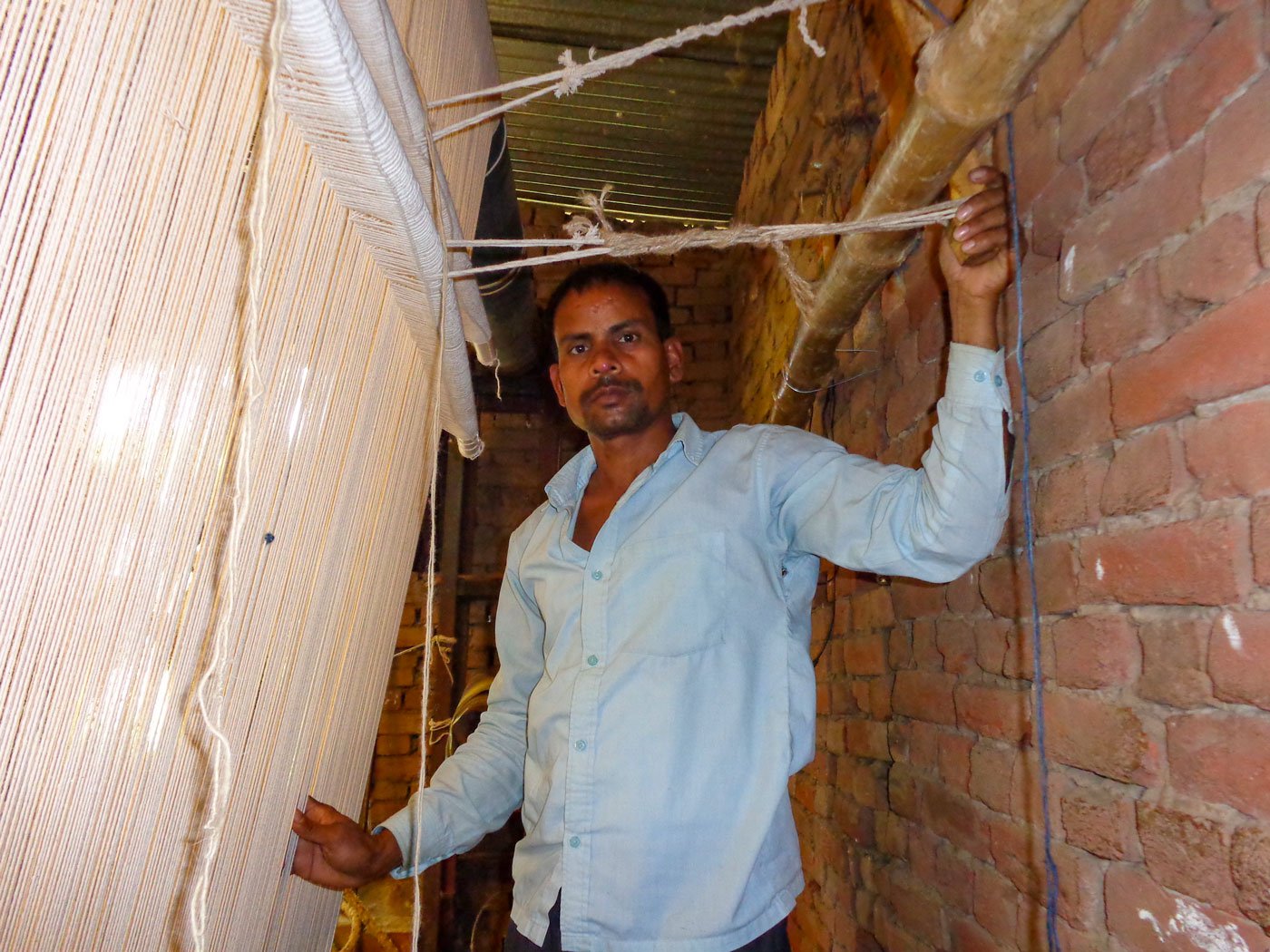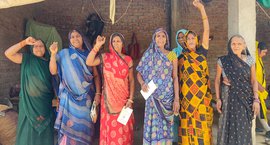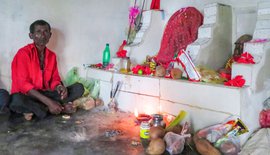Toofani and his team of weavers have been working since 6:30 a.m. At the pace of 12 inches a day, the four of them will take 40 days to finish the 23x6 feet galicha (carpet) they are working on.
At half past noon, Toofani Bind finally sits down to rest on a wooden bench. Behind him, in the tin shed where he works, white cotton threads hang from a wooden frame at his workshop in Purjagir Mujehara village of Uttar Pradesh. This is the heart of the state’s carpet weaving industry, introduced in Mirzapur by the Mughals, and industrialised by the British. UP dominates the national production of rugs, mats and carpets, accounting for half the national output (47 per cent), says the 2020 All India Handloom Census .
The road leading up to the Purjagir Mujehara village gets narrower as one gets off the highway from Mirzapur city. On either side are pucca, mostly one-storeyed houses, as well as kuccha homes with thatched roofs; the smoke from cow dung cakes rising in the air. In the day, men are hardly visible outdoors, but women can be seen doing household chores like washing clothes under the hand pump or talking to a local vendor of vegetables or fashion accessories.
There are no signs that this is a weaver’s locality – no carpets or galicha as the locals refer to it, hang or are stacked outside. Although households have an additional space or room allocated for carpet weaving, once ready, middlemen pick it up for washing and cleaning.
Speaking to PARI as he rests, Toofani says, “I learnt it [knotted weaving] from my father and have been doing this since I was 12-13 years old.” His family belong to the Bind community (listed as Other Backward Class in the state). Most weavers are listed under OBC in UP, says the Census.

Toofani Bind, a weaver from Purjagir Mujehara village, sitting on a paata (wooden bench) in front of the loom


Left: Inside the carpet workshop, the loom is placed in trenches dug on either side of the room. Right: A typical workshop in Purjagir village made of brick and mud
Their home workshops are cramped spaces with mud flooring; the singular window and door left open for ventilation, the loom taking up much of the space. Some workshops, like Toofani’s, are long and narrow to accommodate the iron loom where multiple weavers can work at one time. Others are within the house and use a smaller-sized loom mounted on an iron or wooden rod; the entire family lends a hand to the weaving.
Toofani has been placing stitches with woollen threads on a cotton frame – a technique known as knotted (or tapka ) weaving, tapka being a reference to the number of stitches per square inches of the carpet. The work is more physically demanding than other forms of weaving for the artisan must manually add the stitches. To do this, Toofani has to get up every few minutes to adjust the frame of sut (cotton) using a dambh (bamboo lever). The continuous squatting and rising takes a toll.
Unlike knotted weaving, tufted weaving of carpets is a relatively newer form that uses a handheld machine for embroidery. Knotted weaving is harder and the wages are lower, so many weavers have switched from knotted to tufted in the past couple of decades. Many have quit altogether, the earnings of Rs. 200-350 a day simply not enough. In May 2024, the state’s labour department announced daily wages for semi-skilled labour at Rs. 451, but the weavers here say they are not being paid that amount.
There is competition too, for the Purjagir weavers, says Ashok Kumar, Deputy Commissioner of Mirzapur’s Industries Department. In Uttar Pradesh, carpets are also woven in the districts of Sitapur, Bhadohi and Panipat. “There is a slump in demand that has affected supply,” he adds.
There were other problems as well. In the early-2000s, allegations of child labour in the carpet industry soured its image. The arrival of the Euro made Turkey’s machine-made carpets better priced, and slowly the European market was lost, says Siddh Nath Singh, a Mirzapur-based exporter. He adds that the earlier state subsidy of 10-20 per cent has dropped to 3-5 per cent.
“Instead of earning 350 [rupees] a day for a
10-12 hour shift, why not work in a city for 550 as daily wages,” points out
Singh, who is the former chairman of Carpet Export Promotion Council (CEPC).


The cotton yarn is mounted on iron pipes (left) of the loom and a bamboo lever is attached (right) to the loom for shifting the frame of the yarn
Toofani once mastered the art of weaving with as many as 5-10 coloured threads at one go. But the low wages have dampened his enthusiasm. “They [middlemen] are the ones who commission work. While we keep on weaving day and night, they earn more than us,” he says dejectedly.
Today he earns Rs. 350 for a 10–12 hour shift, based on how much he has been able to weave and his wages are paid at the end of the month. But he says this system needs to go, for it does not take into account the hours he has put in. A lump sum payment of Rs. 700 a day should be paid as labour charges for this skilled work, he feels.
The middleman who gets them the contracts are paid by the gaj (one gaj is about 36 inches). For four to five gaj , which is the length of an average carpet, the contractor will earn around Rs. 2,200 while the weaver will only earn around Rs. 1,200. The contractors, however, pay for the raw material – the kati ( woollen thread) and sut ( cotton yarn).
Toofani has four sons and a daughter who are
still in school and does not want his children to follow in his footsteps. “Why
should they also do the same thing that their father and grandfather have spent
their lives doing? Shouldn’t they study and do something better?”
*****
In a year, the Toofani and his team weave 10-12 carpets, working 12 hours a day. Rajendra Maurya and Lalji Bind who work with him, are both in their 50s. They work together in a small room with a window and a door as the only source of ventilation. Summers are particularly difficult. When temperatures soar, the rooms heat up as the asbestos roof of this semi- pucca structure offers little protection.
“The first step in making a galicha [carpet] is the taana or tananna ,” Toofani says. It involves mounting the frame of cotton thread onto the loom.


Left: Rajendra Maurya, Toofani's co-worker and fellow weaver, straightening woolen thread. Right: Their colleague Lalji Bind says his eyesight has suffered due to long hours of weaving


Left: A hook on the iron beam of the loom prevents the frame of cotton yarn from slipping. Right: Weavers use a panja (iron comb) to settle the stitches
In a rectangular room measuring 25x11 feet, there are trenches on either side where the loom is placed. The loom is made of iron with ropes attached on one side to hold up the frame of the carpet. Toofani bought it on loan five or six years ago, paying back Rs. 70,000 in monthly instalments. “In my father’s time, they used wooden looms placed on stone pillars,” he says.
Every knot in the carpet comprises charri (line stitch) for which the weavers use woollen thread. To keep it intact, Toofani uses cotton thread to form a line of lachhi (U-shaped loops around the cotton yarn). He brings it to the front of the loose end of the woollen thread and cuts it with a chura – a small knife. Then, using a panja (iron comb), he taps the entire line of stitches. “ Kaatna aur thokna [cutting and tapping], that is knotted weaving,” he sums up.
Weaving takes a toll on the artisan’s health. “It has affected my eyesight over the years,” says Lalji Bind, who has been in this profession for 35 years. He has to wear glasses while he works. Other weavers complain of back ache and even sciatica. They feel like they had no other choice but to take up this profession. “Our options were limited,” Toofani says. In rural UP, almost 75 per cent of weavers are Muslim, says the Census.
“There were around 800 families 15 years ago that were into knotted weaving,” recalls Arvind Kumar Bind, a weaver from Purjagir, “today that number has come down to 100.” That's more than a third of Purjagir Mujehara’s population of 1,107 (Census 2011).


Left: Knotted carpet weaving in progress with cotton yarn and woolen threads, with a design map running parallel to the length of loom. Right: Weavers use woolen thread for charri or line stitches


Left: Cotton thread is used to stitch U-shapes loops or lachhi . Right: A chura (dagger) is used to cut the loose woollen thread which will now make the carpet look furry
In another workshop nearby, Baalji Bind and his wife Tara Devi are working silently with full concentration on a soumak, a knotted carpet. The only sound is the occasional snip of threads with a knife. A soumak is a single-coloured galicha with a uniform design, and weavers who have smaller looms prefer making it. “I will get 8,000 rupees for this piece if I finish within a month,” says Baalji.
In both Purjagir and Bagh Kunjalgeer – weaving clusters – although women like Baalji’s wife Tara work alongside and account for almost a third of all weavers, their labour is not acknowledged by others around them. Even children help out in between school and during their summer break, their labour helping things speed up.
Hajaari Bind and his wife Shyam Dulari are
working to finish a carpet in time. He misses his two sons who used to help but
have now migrated to Surat for wage work.
“Bachon ne humse bola
ki hum log isme nahi phasenge, papa
[My children told me, we don’t want to
be trapped in this, papa].”


Left: Baalji Bind with his wife Tara Devi, weaving a knotted carpet known as soumak. It is a single-coloured carpet with a uniform design . Right: Shah-e-Alam showing his set of tufted guns which are now rusting from lack of use


Left: Hajaari Bind has a loom in his house on which he weaves soumak s . Right: Shyam Dulari, Hajaari's wife, standing next to the cotton yarn. In weaving clusters such as Purjagir, women participate in weaving, although their labour goes unacknowledged by those around them
The falling incomes and hard labour are pushing not just the young away, but even 39-year-old Shah-e-Alam, who left weaving three years ago and now drives an e-rickshaw. A resident of Natwa, eight kilometres from Purjagir, he had started weaving carpets when he was 15 years old and over the next 12 years he moved from knotted weaving to becoming a middleman in tufted weaving. Three years ago, he sold off his loom.
“ Posa nahi raha tha [it wasn’t enough to sustain us],” he says, sitting in his two-room newly constructed house. Between 2014 to 2022, he worked as a labourer at a tile-making company in Dubai which ensured a monthly pay of Rs. 22,000. “That at least helped me build this nest,” he says, pointing to the tiled floor. “While I was getting only Rs. 150 per day as a weaver, at least as a driver I’m able to make Rs. 250-300 daily.”
The state government’s One District One Product scheme provides financial aid to carpet-weavers while the central government’s Mudra Yojana helps in availing loans at concessional rates. But weavers like Shah-e-Alam are unaware of their existence despite the awareness campaigns running at the block-level.
A short drive from Purjagir Mujehara, in the neighbourhood of Bagh Kunjal Geer, Zahiruddin is engaged in the craft of gultarash – fine tuning the designs on a tufted carpet. The 80-year-old had enrolled for the Mukhyamantri Hastshilp Pension Yojana. The state government scheme, started in 2018, ensures a pension of Rs. 500 to artisans over the age of 60. But after receiving the money for three months, Zahiruddin says, the pension stopped abruptly.
But he is happy with the rations he receives under the Pradhan Mantri Garib Kalyan Anna Yojana (PMGKAY). Even weavers in Purjagir village told PARI about receiving “ Modi ka galla ” [food grains as part of Prime Minister Modi’s scheme].


Left: Zahiruddin, a resident of Bagh Kunjal Geer, practices the craft of gultarash – fine-tuning designs (left) on a tufted carpet. He holds up a finished tufted carpet (right), which is the size of a doormat


Left: Khalil Ahmed, a Padma Shri-awardee, shows PARI his photo with former Prime Minister Atal Bihari Vajpayee. Right: Designs developed by Khalil after visiting countries like Iran, Brazil and Scotland
For every kilo of cotton thread ( sut ) that Shamshu-Nisa straightens on her iron spinning wheel, the 65-year-old earns seven rupees. That adds up to roughly Rs. 200 a day. Her late husband, Hasruddin Ansari wove knotted carpets before the family shifted to tufted in the early 2000s. Her son, Siraj Ansari is not looking at a future in weaving as he says even the market for tufted weaving has slumped.
In the same neighbourhood as Zahiruddin, Khalil Ahmed lives with his family. In 2024, the 75-year-old received the Padma Shri award for his contribution to durries. Browsing through his designs he points to an inscription in Urdu: “ Is par jo baithhega, woh kismatwala hoga [one who sits on this carpet will have good fortune],” he reads out.
But good fortune is eluding those who weave them.



